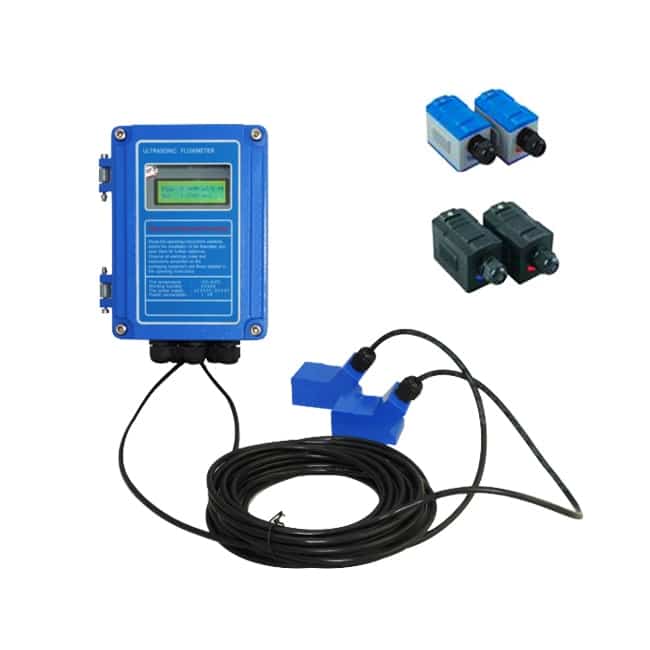What is a flow sensor?
A flow sensor (often called a “flow meter“) is an electronic device component used to measure or regulate the flow rate of gases and liquids in pipes and ducts. Flow sensors are typically connected to meters for measurement, but they can also be connected to computers and digital interfaces. They are commonly used in HVAC systems, medical equipment, chemical plants and water treatment systems. Flow sensors can detect leaks, blockages, pipe bursts, and changes in fluid concentration due to contamination or pollution.
Types of flow sensors
Differential pressure flow sensor
The velocity of a fluid is directly related to the pressure of the fluid, as shown in Bernoulli’s equation.
dp=(density*velocity^2)/2
A differential pressure flow sensor calculates the pressure of a fluid. The sensor measures the pressure at two different velocities, while maintaining the fluid density. In most differential pressure flow sensors, a single pressure sensing node (such as a Pitot tube) is located at the edge of the fluid flow path. A change in nozzle or orifice diameter accelerates the fluid and measures it again at a higher velocity. Once the sensor has determined the pressure difference, we can use Bernoulli’s equation to find the fluid velocity. Finally, we can use that fluid velocity to determine the total flow rate through the pipe.
This process requires controlling several variables to accurately calculate the velocity of the fluid. Therefore, differential pressure based flow sensors are usually components that “interrupt” the pipeline rather than adapt to the existing pipeline. Several different types of sensors use differential pressure methods, such as
- Venturi tube
- Rotor flow meters
- Orifice plates
- Pitot tube arrays
All of these sensors are available with varying degrees of accuracy and system pressure loss. Due to their performance and versatility, differential pressure flow sensors are the most popular type of flow sensor.
Thermal mass flow sensors
Typically used in gaseous, low-flow, high-precision applications, such as semiconductor manufacturing, thermal mass flow sensors use the thermal properties of a fluid to measure the flow through a system. Thermal mass flow systems have one of two basic configurations, but both rely on the tendency of the fluid to absorb thermal energy and measure the energy in the fluid. The following is a brief guide to these two configurations.
Method 1: The heating element and the heat sensing element work together to measure the energy absorbed by the fluid as it flows through the heating element and the heat sensor. First, the fluid absorbs energy from the heating element. Next, the sensor measures the fluid to determine how much energy it has absorbed.
Method 2: A single heating element works to keep the temperature at a fixed level. As the fluid absorbs energy, it cools the heating element, which requires more energy in the system to maintain the temperature. We calculate the mass flow rate by determining the amount of energy used by the heating element to maintain itself at a constant temperature.
In both methods, the speed of the fluid is directly related to how much energy it can absorb. The slower the fluid flows, the longer it takes for energy to be transferred from the heating element to the fluid. The faster it flows, the less time it takes to be absorbed by the fluid. A key component of thermal mass flow sensors is that they must be calibrated for the specific fluid in the thermal mass flow system. Thermal mass flow sensors are fine-tuned to support different levels of gas purity, such as pharmaceutical grade nitrogen versus industrial manufacturing grade nitrogen. When properly calibrated, these sensors can be extremely accurate and reliable, which is why they are so popular in manufacturing environments.
Contact flow sensors
Eddy current sensors and mechanical flow sensors are the common contact flow sensors are. An eddy current sensor consists of a small latch (called a “buffer”) that bends back and forth when in contact with a flowing liquid or gas. The pressure difference (i.e., eddy current) created by the latch is measured to determine the flow rate. Mechanical flow sensors use a propeller that rotates at a speed proportional to the flow rate. Mechanical flow sensors can also be controlled to increase or decrease the flow rate.
Non-contact flow sensors

Ultrasonic flow sensors are the most popular non-contact flow sensors. Ultrasonic flow sensors send high frequency sound pulses through a flowing liquid or gaseous medium. These sensors measure the time between the sound emission and its contact with the sensor receiver to determine the flow rate of the gas or liquid.
Flow sensor applications
There are a variety of flow sensors available to meet niche needs and applications. The most common parameters that affect the type of flow sensor you need are
- Volume range of the flow sensor
- Material
- Pressure
- Required accuracy
Flow sensors are the perfect tool to help you understand and control the mechanical or chemical subsystems in your application. Contact Apure to learn more about technology and product applications.
Extended reading:
Useful information about flow units
Relation between flow and pressure
Ultrasonic flow meter working principle
Select the right water flow meter
